The Dark Crystal debuted in 1982, wedged somewhat oddly between The Great Muppet Caper and the premiere of Fraggle Rock in the Great Muppet Time Line. In terms of Jim Henson’s career, placing the film chronologically is easy; figuring out how it fits into his development as an artist is a bit more complicated. The project that eventually became The Dark Crystal actually began several years earlier when Henson fell madly in love with the work of fantasy illustrator Brian Froud; they became friends, and Froud began collaborating with Henson and Frank Oz. With the help of David Odell, a former staff writer for The Muppet Show, they eventually produced the first live-action film to feature no human actors, only puppets and animatronic creatures.
The film was groundbreaking in many ways, and yet it was not considered a financial success upon release, and is often described as something of a “near classic” even by its fans. I’ve always harbored mixed feelings toward The Dark Crystal; even as a kid, I remember having the sense that there were so many aspects of the movie that worked…but somehow all those amazing parts never seemed to come together, in the end. And so, for the first time in years, I decided to take another look.
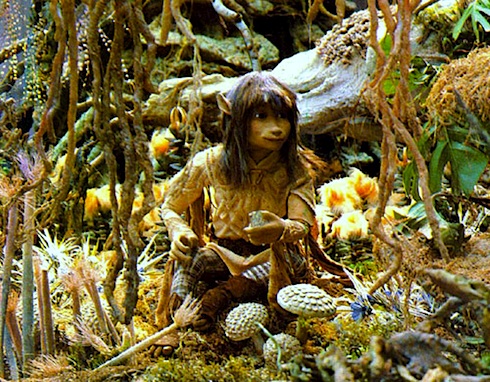
The basic plot of The Dark Crystal centers around Jen, who believes himself to be the last of the peaceful Gelflings; Jen looks a bit like an elf and acts a lot like a hobbit as he’s ripped from his comfort zone and sent upon the quest to fulfill his destiny. He’s fairly brave, but also clueless, and has a tendency to whine about not knowing what he’s doing. The audience knows the score, however, thanks to the helpful narration that opens the movie—a thousand years ago, everything was great until the titular Crystal cracked, and two new races appeared. The corrupt and evil Skeksis took over, while the wise and gentle Mystics went off to practice their “natural wizardry” in a delightfully mellow commune far from the buzz-harshing Skeksi empire.
The movie begins with the simultaneous deaths of the Skeksi emperor and his counterpart among the Mystics, who has raised the orphaned Jen. On his deathbed, Jen’s beloved Master reveals that the young Gelfling is destined to fulfill an ancient prophecy, find the missing shard and heal the Crystal before the planet’s three suns align in the sky—otherwise, the world will descend into eternal darkness. Confused and doubtful, Jen resigns himself to his fate and sets out on his journey….
So far, so good, right? I will say that the first ten or fifteen minutes of the movie seem even darker and more violent than I’d remembered—how many family movies kick things off with two deathbed scenes, followed immediately by a brutal battle for power between rival Skeksis? Featuring giant axes, and a lot of shrieking. It’s intense. So, maybe this isn’t a movie for the faint of heart, but at least we know where the story’s going, and we can settle in for a classic quest narrative….
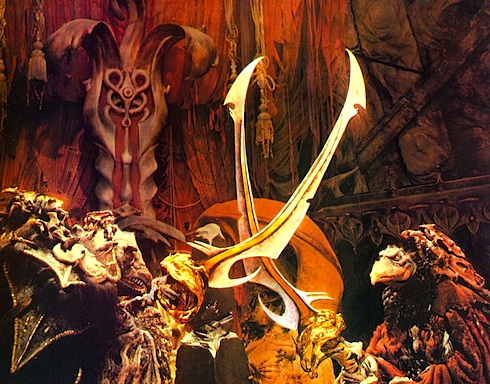
Unfortunately, during the first two thirds of the movie, tagging along on Jen’s journey means slogging through A LOT of exposition, a good deal of which seems unnecessary thanks to the opening narration. Perhaps I wouldn’t mind if Jen were less of a milquetoast, but in Muppet terms, he’s kind of like an emo Kermit the Frog, if Kermit were robbed of any detectable sense of humor or gumption, wringing his hands and kvetching (or whatever the Gelfling equivalent of kvetching is), from one scene to the next. Luckily, he soon encounters a couple of far more interesting characters in the form of Aughra, the scholar who supplies him with the missing crystal shard, and Kira, a fellow Gelfling.
Aughra, it must be said, is pretty amazing. She’s vaguely terrifying, brilliant, no-nonsense, and fearless in the face of the Skeksis and their huge, crustacean-like henchman (hench-creatures?), the Garthim. Plus, her observatory is one of the most magnificent set pieces in a film brimming with magnificent visuals—it’s absolutely breathtaking. I remember being slightly scared of Aughra as a little kid, but also really liking her, and I stand by that reaction; she’s a bit of a benevolent bully, but Jen desperately needs a bit of bullying to send him on his way.
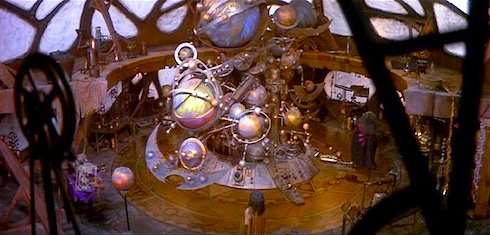
After Aughra is attacked and captured by the Skeksis, Jen is lost again until he meets up with Kira. A much more dynamic character than Jen, Kira is savvier, more adventurous and self-reliant. The movie also makes a point of playing up the fact that she’s a female, which is interesting given the asexual appearance of most of the other creatures in the movie: Kira uses her wings to carry Jen to safety in one scene, much to Jen’s surprise: “Wings! I don’t have wings!” he exclaims; “Of course not,” Kira answers, “You’re a boy.” Kira is fearless and committed to the quest; she’s everything that Jen is not, in other words, and only through her eventual sacrifice is he able to finally reach the Crystal and do what needs to be done. The gender politics of the film are certainly interesting… and while it would be nice if The Dark Crystal offered interesting gender politics AND a genuinely interesting protagonist, at least the supporting characters are ready, able, and willing to steal the show.
For all my own kvetching, as I mentioned in the beginning, what this movie does well, it does spectacularly well. Henson and Froud managed to create amazingly detailed, lush, gorgeous settings and populate those settings with creatures that look like nothing on earth—utterly fantastic, but also somehow believable. When designing the various characters and concept art, Froud avoided modeling his creatures after existing, real-world animals, so what we see on the screen is essentially his imagination brought to life through the skill and technical innovations of Oz and Henson.
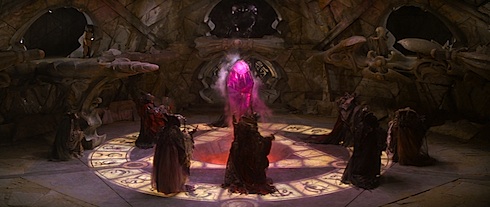
Even if the movie had been completely silent (or had featured a constructed language, as Henson had originally planned for the Skeksis’ scenes), the film would still rank as a major milestone, even in a career as brilliant as Jim Henson’s. As a narrative, it might have a few flaws, but as work of fantasy art and a triumph of puppetry, animatronics, and the sheer force of talent and imagination, there’s no denying the power of The Dark Crystal.
This article was originally published November 16, 2011 as part of our Muppet Week series.
Bridget McGovern really needs to share this early deleted scene in which Frank Oz performs the voice of Aughra. You haven’t really lived until you’ve heard the voice of Fozzie, Bert, Yoda and Evil Grover casually discussing the coming apocalypse. Either I need a drink, or Aughra needs an exorcism. Probably both.










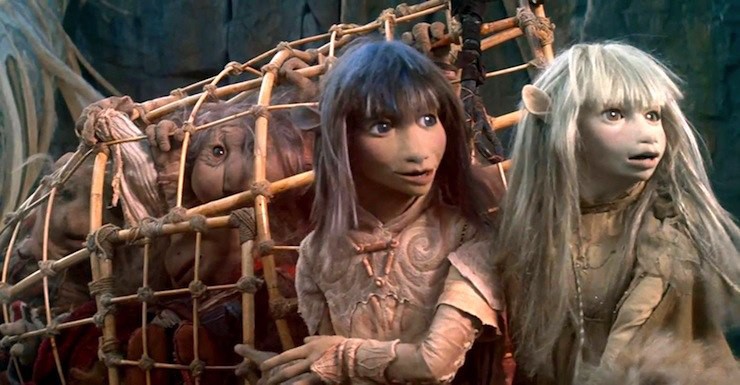
The comparison between Jen and Kermit is fitting, since Jim Henson was the puppeteer for Jen, as Frank Oz was for Aughra. They redubbed the voices, though — I think because their own voices were too familiar from the Muppets, and Henson wanted to differentiate this from the Muppet movies. (In preferred Henson terminology, the characters in TDC are Creatures, not Muppets, because they’re designed to simulate living beings rather than being obvious puppets with caricatured features.) Kira was puppeteered by Kathryn Mullen and Fizzgig by Dave Goelz (Gonzo).
I’ve always been a fan of The Dark Crystal, and I regretted that we didn’t get sequels, or at least followups in the same vein. Labyrinth was a real disappointment for me, both in that it included human characters and in that it revolved so heavily around David Bowie, whom I didn’t find at all effective as a villain, let alone as a singer. Plus its story just didn’t work as well for me. I don’t think it did that well at the box office either, which is why we didn’t see any further such attempts by Henson. Although I see that TDC was more a critical success than a financial one, except in Japan and France.
@ChristopherLBennett
While there haven’t been any film sequels to TDC, there have been a few literary follow-ups. They just finished publishing an excellent graphic novel series (Creation Myths), and then there was a forgettable “manga” that lasted all of two volumes (Legends of Dark Crystal). Also, next year, we can look forward to this:
http://www.amazon.com/Shadows-Dark-Crystal-Jim-Hensons/dp/0448482894
Also, did you see Mirrormask?
@2: Yeah, Mirrormask was pretty interesting.
There are plenty of bloodier Dr Who episodes. And remember that bit in the Hobbit where one of the good guys shows off the heads and skins of his enemies – the day after capturing them. (Although I doubt that is in the film.) It is nice to give the kiddies a bit of bloodshed from time to time.
Editorial nitpick; “Skeksis” is both singular and plural. And there are some live actors on screen at times; during wide shots the Gelflings are played by what appear to be child (or very slim) actors in costume –on a technical level, I’m impressed at how often the film cuts just before someone’s face turns toward the camera (the only tell that I’ve found is Jem’s extra finger when he enters the Skeksis catacombs).
(I’ve also tried to figure out how the Great Conjunction works, and can only assume that the smaller “Dying sun” is actually a large gas giant, possibly a protostar, with the Great and Rose suns as a giant and a red dwarf companion.)
As you can tell, I am a complete geek about this movie.
It’s true that Jen is very meek, and not very strong-willed or even especially personable. But he’s had a milder upbringing, taught greater knowledge (he can read, Kira can’t, for example) and less on survival (she knows the calls of beasts and can use a slingshot!). In some ways he’s Frodo, strong enough to carry out the quest, get the bauble, and carry it all the way to the villains’ own lair…but he’s not exceptional at every turn. That’s what the others are for. He’s more of the everyman in this tale, the one we’re all like and can most relate to.
I disagree that he’s the protagonist, though. I think the moment Kira arrives, they share the label as protagonists equality. They’re the legacy of the whole Gelfling race, and without the actions of both, the quest would have failed.
Those Mystics sure are fast for a bunch of slowpokes, aren’t they? :)
@5/Cybersnark: Were the child actors actually bare-faced, or were they wearing masks? Lots of the creatures in TDC, like the Skeksis, Mystics, Garthrim, and Landstriders, had human beings entirely inside them (sometimes more than one). So there were plenty of live performers on the set, just not in plain view. (Also, a camera double doesn’t constitute an actor.)
Brown dwarf stars could potentially support habitable planets in close orbits, and would cool down over time. But their radiation would be mostly in infrared, so such a planet would be very dark. It’s fantasy, though; stars can work however they want.
As far as I can tell, from what I remember, the only way the “triple suns” would work is if at least two of them (the inner two) are actually orbiting around the planet and not in the same plane.
I still like almost everything about this movie; unfortunately, Jen is not one of the things I like …
@CLB
that it revolved so heavily around David Bowie, whom I didn’t find at all effective as a villain, let alone as a singer
Oh, well, you’re dead to me now.
You obviously are not a part of the generation who got their sexual awakening at the hands of Jareth the Goblin King and His Codpiece